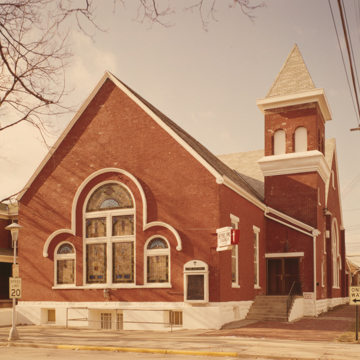Bethel African Methodist Episcopal (AME) Church was an important center for Indiana's Black community during the mid-nineteenth century. This church is also associated with the western expansion of the AME Church, an effort most embodied in the domestic missionary work of William Paul Quinn, the fourth Bishop elected to AME Church leadership in 1844. Quinn is notable in AME history for expanding the church between the Midwest and the Pacific Coast prior to the American Civil War, at a time when laws in these territories discriminated against and barred Black western migration. In 1836, Quinn was elected the AME Church’s first authorized missionary to the northwest territories. While the overall goal was to spread African Methodism throughout the western half of the United States, his specific task was to establish churches in Ohio, Indiana, and Illinois. Quinn established an AME church in Richmond, Indiana, in 1838. By 1842, due to Quinn’s efforts, there were close to 900 AME congregants and forty-nine churches in the formerly known Western AME conference, with the Richmond AME church serving as a focal point. In addition, Richmond became an important site for Black migration as the abolition activity supported by the Quaker community allowed Black Americans to freely operate their own cultural institutions.
The German Methodist Church supervised the construction of the original Bethel AME church building in 1854. After the German Methodists merged with a nearby Methodist congregation, the property was transferred in 1857 to the Hicksite Friends (active abolitionists involved in the Underground Railroad), who then sold the property to the AME Church, then under Quinn’s direction, in 1868. The name “Bethel” references the original Mother Bethel located in Philadelphia, Pennsylvania, which became the center for Black autonomy in the late eighteenth and early nineteenth centuries, when Black Methodists separated from the Methodist Episcopal Church and funded building projects to establish their own separate places of worship.
The one-story brick church was built as a typical Methodist meeting house, with a rectangular plan and Greek Revival detailing. The building doubled in size during an 1892 renovation, which involved an addition to the western end that resulted in a cruciform plan, and also included a simple mixture of Romanesque Revival and neoclassical detailing on the exterior. Due to this expansion, the original structure became the eastern section of the church, serving as the vestibule; the original entrance on the east side was replaced with three large windows. Tripartite windows above the original altar and the original pulpit were replaced with double doors leading into the 1892 addition. Stained glass windows filled openings on the north and south elevations. A three-story entry and bell tower mark the northeastern corner, which is formed by the intersection of the original church and the northern end of the 1892 addition. Inside, the church's original ash wood flooring is now covered in linoleum.
In 1975, Bethel AME was added to the National Register of Historic Places as an important example of nineteenth-century Black institutional building in the midwestern United States. The church continues to hold regular religious services.
References
"Bethel African Methodist Episcopal Church," Wayne County, Indiana. National Register of Historic Places Inventory-Nomination Form, 1975. U.S. Department of the Interior, National Park Service, Washington, D.C.
Dickerson, Dennis C. The African Methodist Episcopal Church, A History. New York: Cambridge University Press, 2020.
Palmer, Ronald, D. F. “AME Bishop William Paul Quinn: Notes Toward a Biographical Chronology of an American Original.” The AME Church Review 120, no 395 (July-September 2004): 40-61.
Payne, Daniel Alexander. History of the African Methodist Episcopal Church. Nashville: Publishing House of the A.M.E. Sunday School Union, 1891.

